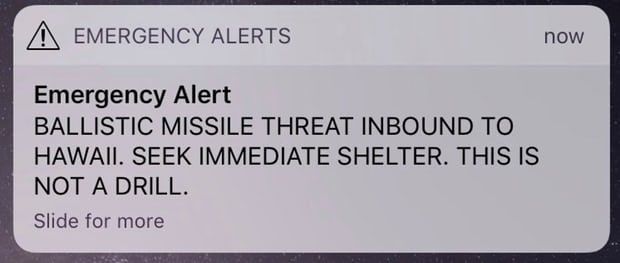Hawaii was in a state of panic for about 30 minutes.
Following the recent alert that about an incoming ballistic missile that sent Hawaii into a panic, the Hawaii Emergency Management Agency (HI-EMA) has confirmed that there was no ballistic missile and that there were no computer hacks to the HI-EMA system. The cause of the false alarm was human error.
The alert, which was sent to cellphones, said there was a threat “inbound to Hawaii” and that residents should seek shelter. “This is not a drill,” it added.
The phone message notification, all in capital letters, went out at 08:07 (18:07 GMT).
It was corrected by email 18 minutes later but there was no follow-up mobile text for 38 minutes, the Honolulu Star-Advertiser reports.

The HI-EMA have released a statement regarding the events that unfolded:
“HI-EMA has already taken measures to ensure that an incident such as the one that occurred this morning does not happen again. HI-EMA has also started a review of cancellation procedures to inform the public immediately if a cancellation is warranted. We understand that false alarms such as this can erode public confidence in our emergency notification systems. We understand the serious nature of the warning alert systems and the need to get this right 100% of the time.”
“I know first-hand how today’s false alarm affected all of us here in Hawaii, and I am sorry for the pain and confusion it caused. I, too, am extremely upset about this and am doing everything I can
do to immediately improve our emergency management systems, procedures, and staffing,” said Governor. David Ige.
In an interview with CNN, Ige elaborated on the mistake. “It was a mistake made during a standard procedure at the change over of a shift, and an employee pushed the wrong button,” he said.
Ige then said that he was meeting with top defense and emergency management officials from the state “to determine what caused this morning’s false alarm and to prevent it from happening again.”
I am meeting this morning with top officials of the State Department of Defense and the Hawaii Emergency Management Agency to determine what caused this morning’s false alarm and to prevent it from happening again.
— Office of the Governor, State of Hawai`i (@GovHawaii) January 13, 2018
Ajit Pai, chairman of the US Federal Communications Commission, announced the investigation on Twitter.
The @FCC is launching a full investigation into the false emergency alert that was sent to residents of Hawaii.
— Ajit Pai (@AjitPai) January 13, 2018
JUST IN: Hawaii Governor David Ige tells CNN that someone "pushed the wrong button" during an employee shift change, sending out the false alert about an incoming ballistic missile https://t.co/FD1vl6fCzh pic.twitter.com/2zhXLApLcr
— CNN (@CNN) January 13, 2018
Ige also apologised for the “the pain and confusion it caused” while promising to undertake a whole review of the HI-EMA operational procedure. He also pleaded for better relations with North Korea “so that warnings and sirens can become a thing of the past.”
Today is a day most of us will never forget. A terrifying day when our worst nightmares appeared to become a reality. A day where we frantically grabbed what we could, tried to figure out how and where to shelter and protect ourselves and our ohana, said our “I love yous,”
— Office of the Governor, State of Hawai`i (@GovHawaii) January 14, 2018
and prayed for peace.
I know firsthand how today’s false notification affected all of us here in Hawaii, and I am sorry for the pain and confusion it caused. I, too, am extremely upset about this and am doing everything I can to immediately improve our emergency mngment systems
— Office of the Governor, State of Hawai`i (@GovHawaii) January 14, 2018
,procedures and staffing.
I have spent the morning with Gen. Logan, Hi-EMA Administrator Vern Miayagi and their teams and have directed that they make immediate changes. We are doing everything we possibly can to prevent this from happening again.
— Office of the Governor, State of Hawai`i (@GovHawaii) January 14, 2018
I encourage all of us to take stock, determine what we all can do better to be prepared in the future-as a state, county and in our own households. We must also do what we can to demand peace and a de-escalation with North Korea,
— Office of the Governor, State of Hawai`i (@GovHawaii) January 14, 2018
so that warnings and sirens can become a thing of the past.
— Office of the Governor, State of Hawai`i (@GovHawaii) January 14, 2018
The full timeline of events can be found here
Topics:
NewsRELATED ARTICLES






MORE FROM JOE



















MORE FROM JOE




















